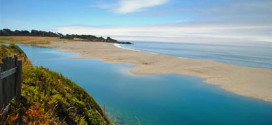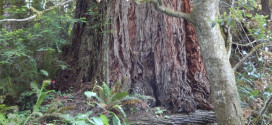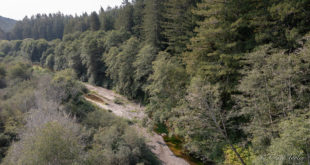by Tempra Board
Soundings, Summer, 2019
© copyright 2019, The Sea Ranch Association
reprinted with permission
Friends of Gualala River (FoGR) has been in the news lately for its efforts to compel state agencies to protect sensitive Gualala River watershed habitat from the latest in a series of Timber Harvest Plans (THPs) proposed by the Gualala Redwood Timber (GRT) company.
Get ready for some acronym soup. Though this article gets into the weeds a bit, it’s worth it to understand why FoGR exists and what it has done to protect the Gualala River and its inhabitants. Made up of local residents on both the Mendocino and Sonoma County sides of the river, this all-volunteer organization has been a powerhouse of community organizing, advocacy, and legal efforts to protect the watershed since 1992.
Even if you aren’t a fly fisher or river user, and even if you never step foot in the floodplain of the Gualala River, or enjoy the habitat and view of the river mouth as you drive into Gualala (though that would be hard to believe), as a TSR member, there may be another reason to be concerned about the state of the Gualala River: it directly affects the source of our drinking water.
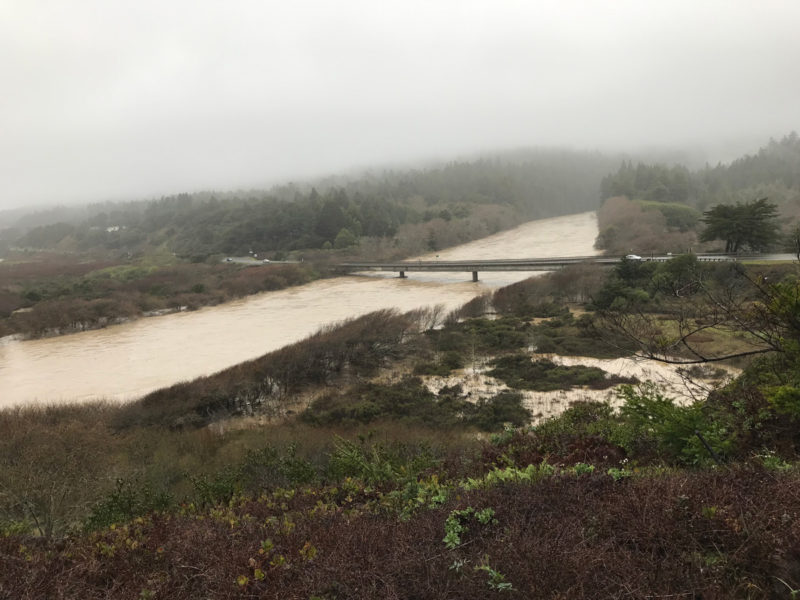
Where do we get our water?
The Sea Ranch gets its water from two 100-foot wells near the Hot Spot, below the Gualala River. While this is considered a groundwater source (rather than surface water, like the river), the two are connected. When the Gualala River is low in the summer, the State mandates that TSR stop pumping water from our wells, because it recognizes that such pumping will result in reduced flow in the river; groundwater and surface water are connected. According to Brian Murphy, operations manager of TSR Water Company, “they [the river and wells] are part of the same aquifer.” That is one reason the Sea Ranch built a 98-million-gallon reservoir that it fills during the rainy season, and uses in the summer when pumping from the wells must stop.
Our northern coastal community, though it seems wet compared to southern California, is precarious when it comes to water. Not only do we have dramatic wet and dry seasons here, our proximity to the ocean means there is less water being captured in underground aquifers. A moratorium on building continues in Gualala due in part to a lack of available water (and the fact that one family owns the water rights, but that’s another article). Therefore, the water table, including the availability of groundwater for drinking and surface water for fish and recreation, must be protected.
The History of FoGR
FoGR was formed in 1992 by local residents concerned about a logging plan near a popular campground on the north bank of the Gualala River. Ten years later in 2002, the group became further organized and established as the local watershed protection group in response to a bizarre scheme by an Alaska-based company to bag Gualala and Albion River water and send it to southern California communities. Then in the early 2000s, FoGR became a leading voice in an effort to stop the California Public Employees Retirement System (CalPERS), which had purchased nearly 20,000 acres of forestland near Annapolis, from developing it into high-end vineyard properties. Such a use would have cut forests and depleted the water table for thirsty pinot noir grapes. According to the SF Chronicle, the plan would have “involved construction of about 40 small reservoirs, 90 miles of roadway and 100 miles of fencing to keep out the wildlife.” FoGR launched a community protest and gathered 91,000 signatures from inside and outside the region against the development. FoGR’s and other groups’ advocacy helped lead to the largest conservation deal in California’s history: the purchase of the property by The Conservation Fund in 2013.
FoGR’s current focus is on the lower Gualala River watershed and the Dogwood THP.
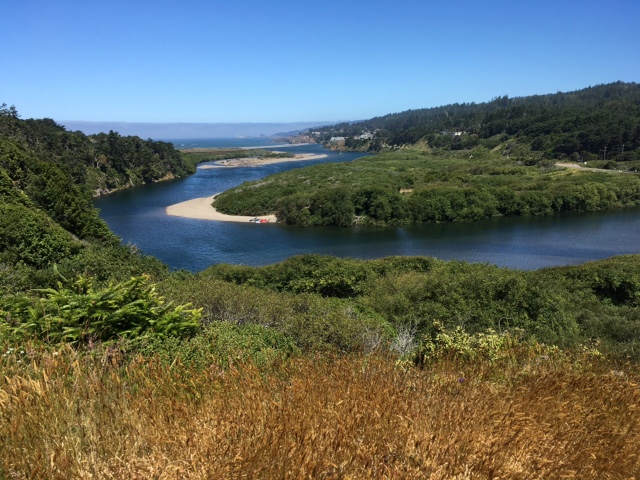
What is the Dogwood THP?
The latest logging plan by GRT, called the Dogwood THP, is a submittal to the California Department of Forestry and Fire Protection (CAL FIRE) for the same tract of land that GRT, and the former landowner, Gualala Redwoods Inc. (GRI), has been trying to log for nearly 20 years. Back in 2001, logging plans were denied by CAL FIRE after the National Marine Fisheries Service (NMFS) determined that they would likely result in harm to endangered salmon. When GRI filed two new THPs in 2004, nearly identical to the 2001 plan, the NMFS again determined the plans would cause harm to endangered salmonid species. GRI then withdrew the plans.
In 2015, GRI, owned by the Edmunds family, sold more than 30,000 forested acres in the Gualala River watershed to the Burch Family, owners of GRT. At the time, there was an offer on the table from a consortium of environmental groups to purchase the property for conservation purposes, but the landowner chose to sell to a buyer who would keep the land in timber production. Not long after, GRT filed the Dogwood THP, again proposing to log 100-year old, second growth trees that have regenerated following historical logging around the turn of the 20th Century.
The problem, in part, is that these trees lie in the floodplain of the river, and according to FoGR, would “cover most of the floodplain forest left in the lower Gualala River.” Interestingly, the California Forest Practice Rules, which are implemented by CAL FIRE and which timber companies must follow, specifically protect against logging disturbances in “stream-side buffer zones” and “flood-prone areas.” However, the current CAL FIRE Director Ken Pimlott provided an exemption to these rules in order to approve the Dogwood THP.
FoGR helped rally the community and despite hundreds of public comments against the plan, it was approved by CAL FIRE in 2016. FoGR joined with Forests Unlimited and later the Dorothy King Young Chapter of the California Native Plant Society to file a lawsuit against this approval and won, when a Sonoma County Superior Court remanded the THP back to CAL FIRE for environmental review. After a second version of the Dogwood THP was filed, without adequate changes to protect the watershed and its fish and other wildlife, FoGR sued again, and again prevailed. However, Dogwood was submitted once again earlier this year, and the public comment period closed in early May.
Curiously, the NMFS has of late been mum on the Dogwood THP, providing no comments on the plan since their early concerns over the nearly identical plans submitted back in 2001 and 2004. However, members of FoGR have met with scientists at the California Department of Fish and Wildlife office in Fort Bragg, who share the community’s concerns about wetland impacts from THPs in the floodplain.
“We found common ground and frustration with the way the comment period went,” says Jeanne Jackson, local author and FoGR Board Member. “They care about rare plants and feel frustrated that their comments have not been taken into account.” Aside from the sediment caused by removal of trees, the practice of logging in the floodplain can have enormous impacts to fragile wetlands near the river due to skid roads and other disturbances.
According to current FoGR President and fly fisherman, Charlie Ivor, the Dogwood THP is just the tip of the iceberg. “We know that GRT wants to apply for several other floodplain logging plans in the future,” Charlie adds. “That’s what we’re up against.” What happens with Dogwood could set the precedent for what CAL FIRE permits in the future.
Another solution: Gualala River Park
Many in the community now believe that as long as the land in the lower Gualala River watershed is owned by a logging company, the river will remain threatened. As Jeanne puts it, “CAL FIRE has rubber stamped everything. They never met a THP they didn’t like.” There is considerable momentum building for a land purchase that would conserve the floodplain. Sonoma County Regional Parks has funding lined up and a local group of organizers has formed The Gualala River Park Coalition to garner community support. Adjacent land—the 112-acre Mill Bend property—is currently in escrow with a conservation buyer. That property, which includes the Gualala River estuary west of Highway 1 and extending up toward the Gualala Arts Center, does not have marketable timber and was never sold to GRT.
The proposed Gualala River Park would dramatically expand the Gualala Point Regional Park, preserving seven miles of wooded river corridor from Mill Bend to the Annapolis Road crossing above the TSR Hot Spot. This would open up the lower Gualala River to recreation, community education, and environmental stewardship. “FoGR fully supports the concept of the Gualala River Park, and any other efforts to preserve land in the Gualala River watershed,” adds Jeanne. “I look forward to the day that FoGR can put litigation behind them and we can become more about education and public access. There are many things we’d like to do, from citizen water quality monitoring to restoring the fisheries.”
What you can do
So far, GRT has not been willing to sell its timber lands to the County. Yet Sonoma County Regional Parks has listed the Gualala River Park to be one of its top five park priorities and it is included in the 2020 update of its General Plan. Hundreds of local community members have already signed a petition in support of the park (and signatures can still be added on the Gualala River Park website). Representative Jared Huffman, chair of the House Committee on Natural Resources’ Water, Oceans, and Wildlife Subcommittee, has met with members of the Gualala River Park Coalition and is reportedly listening. Interested citizens can contact him, as well as Mendocino and Sonoma County boards of supervisors, and our state representatives, Senator McGuire and Assembly member Wood, and express your opinion on the Gualala River Park. For more information on the river park, go to www.GualalaRiverPark.org.
FoGR needs additional funds to continue its advocacy and legal efforts on the Dogwood THP. For more information, go to their website at www.GualalaRiver.org.
Originally published in
Soundings, Summer, 2019
The Sea Ranch Association
PO Box 16
The Sea Ranch, CA 95497-0016
 Friends of Gualala River Protecting the Gualala River watershed and the species living within it
Friends of Gualala River Protecting the Gualala River watershed and the species living within it
